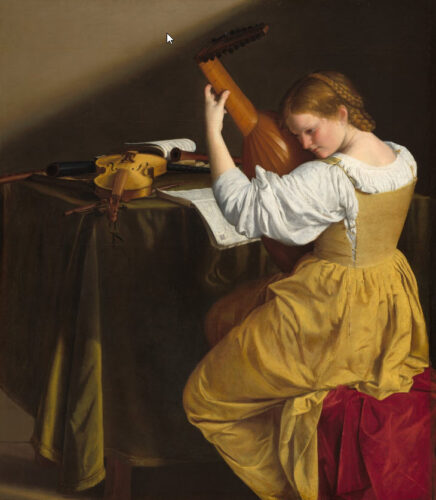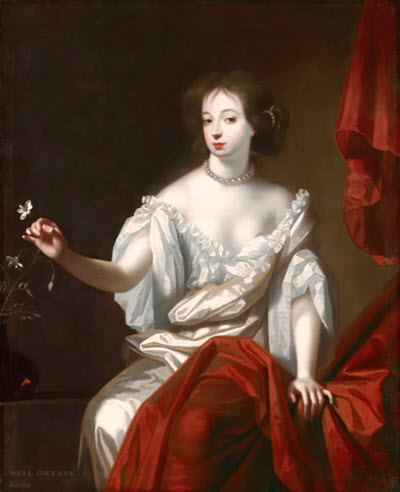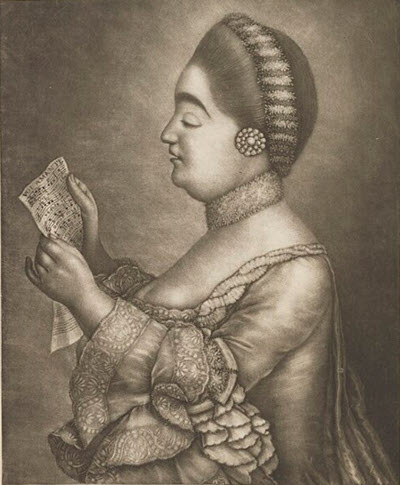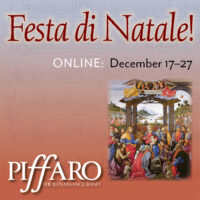The lack of surviving primary sources is an obstacle to telling the stories of early modern women musicians
Narratives on historical women musicians should not put the protagonist into a position of deference to the important men around her
This article was first published in the May 2025 issue of EMAg, The Magazine of Early Music America
The past 30 years of feminist scholarship have uncovered the stories of countless historical women who were involved in nearly every facet of musical life, from performers and composers to engravers, copyists, teachers, and patrons. In addition to discovering women who were connected to music-making, there is also the ongoing critical work of making what we know about these women’s musical contributions accessible to the public. As we reshape and expand our historical narratives to include women’s labor, it is important that we craft their stories with care.
In my own work as a harpsichordist, scholar, and educator, I find it invigorating — sometimes overwhelming — to know there’s always something new to discover about women’s roles in music-making. As an early modern area editor for Grove Music Online’s Women, Gender, and Sexuality project, I have spent time reflecting on how to craft women’s biographies.
Making Her the Subject
Perhaps the most significant issue is making early modern women musicians the primary subject of their own stories — creating a narrative that does not put the protagonist into a position of deference to the important men around her. When the stories we tell about early modern women are mostly focused on the women’s relationships with prominent men, we perpetuate two latent biases: One, that musical women were only successful in the past because of their connections, or, two, that they are only worth having their stories told today because of their validation by other important historical figures. We shouldn’t write men out of history, downplay the importance of respected historical figures, or falsely inflate the accomplishments of historical women. That type of extreme rewriting of history is just as damaging to an authentic historical narrative as subordinating an early modern woman to the powerful musical men around her. A nuanced balance is always required, and it will differ in every situation.
We shouldn’t write men out of history, downplay the importance of respected historical figures, or falsely inflate the accomplishments of historical women
The composer and soprano Elizabeth Turner, for example, was one of the first Englishwomen to publish a substantial book of music. An impressive 464 people subscribed to her 1750 book of songs,and her 1756 collection of songs and harpsichord lessons had 356 subscribers. We know that Turner was respected by her colleagues: At least 34 professional musicians subscribed, including those with whom Turner regularly collaborated, such as William Boyce, who also hired her as a soprano, as well as Gaetano Guadagni, John Beard, Isabella Young, and Abraham Brown. Much of Turner’s repertoire as a soprano consisted of arias by Handel and Boyce. Her 1756 book was one of only 15 scores that Handel himself subscribed to during his time in England. The reach of Turner’s compositions broadened substantially in the final decades of the 18th century, when nine of her songs were reprinted in The Lady’s Magazine and distributed to some 15,000 readers — more than three decades after her death in 1756.
Focusing on the social conventions that stifled artistic creativity can exacerbate the stereotype that early modern women were so oppressed that they were hindered from meaningful music-making
Our understanding of Turner’s career is deepened by knowing her connections to Boyce and Handel, but her musical legacy can stand on its own. When we write about early modern women, the way we structure sentences has a profound impact on the narrative. After all, when a woman is not the active subject of most of the sentences in her biography, she is not being given agency in the retelling of her story.

It can be challenging to address historical trends of sexism and other forms of discrimination that impacted most women. Focusing on the social conventions that stifled artistic creativity can exacerbate the stereotype that early modern women were so oppressed that they were hindered from meaningful music-making.In spite of these systemic barriers, women were able to play a critical role in the development of Western classical music. In her book Francesca Caccini at the Medici Court: Music and the Circulation of Power, Suzanne Cusick seeks to answer the crucial question of “How did she get away with it?” In a cultural landscape where women did not always have the same educational and professional opportunities as men, what unique circumstances allowed Caccini to have a tremendously fruitful career? When we celebrate the ways early modern women successfully navigated circumstances where they had fewer privileges than their male contemporaries, we can reorient our story to focus on each woman’s achievements.
Stitching Together a Narrative
One of the most substantial obstacles to telling early modern women musicians’ stories is a lack of surviving primary sources. In many cases we cannot even ascertain the most basic biographical details, such as a woman’s birth or death dates, the identities of her parents, or the identities of her teachers. Additionally, some women published their compositions anonymously, with a pseudonym, or under their husband’s names, creating a layer of ambiguity when trying to confirm authorship. Yet there is still much information that can be gleaned from what survives. Figuring out where to look for clues and deciding how to stitch them into a narrative when you are missing key biographical markers requires persistence and a bit of creativity. It is often possible to use the information that does survive to better understand a woman’s musical training and influences, the resources she may have had, the repertoire she might have known, her social class, and the members of her personal and professional networks.
At first glance, the key biographical data we have about our example, Elizabeth Turner, could easily lead to the conclusion that we know little about her. Indeed, we do not know who Turner’s parents were, with whom she studied music, or the year of her birth. Yet after years of detective work, I have found that we actually know quite a lot about her.
My findings on the composer and soprano will be published in longer form at a later date, but here are some of the processes I used to reconstruct her life and career from four main source types: the subscription lists and scores for her 1750 and 1756 publications; advertisements about her performances and publications in a variety of British newspapers; death notices; and three anonymous laudatory odes published shortly after her death. Each of these sources has helped me gain insight into Turner’s professional activities, musical style, and network.
From Turner’s subscription lists, I learned that she had more subscribers to her publications than the majority of her London colleagues publishing similar collections, and also that her subscribers spanned a variety of professions and social classes. There are artists, actresses, scientists, doctors, merchants, nobles, and even two politicians who would each become prime minister. Most of Turner’s subscribers lived across Great Britain, but several also resided in Aleppo, Constantinople, Danzig, St. Petersburg, and various cities in Barbados, Jamaica, and Italy. Advertisements for Turner’s concerts allowed me to piece together how frequently she performed, the musicians with whom she collaborated, where her concerts took place, and the repertoire she sang. Since tickets to the concerts were sold at her home, the advertisements also reveal where Turner lived during the active years of her career. Between 1744 and 1756, Turner’s residences were in close proximity to the London venues where she performed most often: Hickford’s Great Room, the Great Room on Dean Street, the Crown Tavern, and the Castle Tavern.
Turner’s Six Lessons for the Harpsichord demonstrate that her musical style is both rooted in tradition and on the cutting-edge of new mid-century trends, and they suggest that she likely had access to a harpsichord with a key compass of nearly five octaves. We learn in Turner’s death notices and the laudatory odes that she was beloved by audiences and died unexpectedly at a seemingly young age. Ultimately, there are so many fascinating aspects of Turner’s rich musical career that determining her birth year or finding the identities of her parents and teachers has become of secondary importance to me.
Contextualizing Historical Criticism

Early modern women musicians, especially those who performed in public, were often described in print with language that ranges from subtly problematic to profoundly vulgar. Rather than just dropping a particularly insidious quote about a woman into program notes or a pre-concert talk, we owe it to the historical women who are being described pejoratively to put these words into their proper context. If we neglect to do so, we risk further defaming the woman and creating a narrative for her that is negatively skewed by just one historical author’s point of view. This is especially critical for women who have no surviving documents from their own perspective.
Nell Gwyn, for example, was among the first generation of singer-actresses to take the public stage in Restoration England. A woman with a compelling rags-to-riches story, she began working in the theater selling oranges and ultimately became one of the most renowned comic actresses of her time. Despite her successes, Gwyn’s professional accomplishments were often overshadowed in the press with scandalous accounts of her romantic relationship with Charles II. One such anonymous lampoon, c.1669, reads:
Hard by Pell-Mell, lives a wench cal’d Nell,
King Charles the second he kept her,
She hath got a trick to handle his [prick]
But never lays hands on his Scepter.
All matters of State, from her Soul she does hate,
And leave[s] to the Pollitick Bitches,
The Whore’s in the right, for ’tis her delight,
To be scratching just where it itches.
Much of the criticism levied against Gwyn was surely an expression of dissatisfaction with the King’s political practices and romantic liaisons. However, it was more socially acceptable to blame a lower-class woman who was perceived as transgressively entering upper-class spaces. When the power and class dynamics are not considered in these debasing accounts, Gwyn is reduced to an opportunity-seeking whore — thus effectively negating her art, career, and agency.
In some instances, primary sources about early modern women musicians completely omit commentary on the women’s musical accomplishments and instead focus on superfluous extramusical details. This is the case in a 1719 letter written by the librettist Paolo Antonio Rolli to his friend Giuseppe Riva. When Rolli learned that the Italian prima donna Margherita Durastanti would be coming to sing Handel’s operas in London, he wrote: “It is said for certain that Durastanti will be coming for the Operas: Oh! What a bad choice for England! I shall not enter into her singing merits, but she really is an Elephant!”
Primary sources often completely omit commentary on the women’s musical accomplishments and instead focus on superfluous extramusical details.
By this time, Durastanti had already established herself as a successful opera singer in Venice, Parma, Naples, and Dresden. Durastanti enjoyed a long working relationship with Handel in London, singing a number of roles he created for her. Rolli’s letter is unfortunately not a rare example of criticism about a woman musician that focuses on elements unrelated to her musical abilities. This remains a problem today in music criticism, where the appearance and clothing of women and gender marginalized performers are commented upon much more often their male counterparts.

Sometimes descriptive language is subtler in the way it undermines a woman’s accomplishments. Charles Burney, for example, mentions the soprano Giulia Frasi several times in his A General History of Music. He writes that “Frasi was at this time young, and interesting in person, with a sweet and clear voice, and a smooth and chaste style of singing, which, though cold and unimpassioned, pleased natural ears, and escaped the censure of critics.” Later he says that “her greatest admirers allowed that her voice and manner would have been still more irresistible, if she had had a little more female grace and softness.”
Burney’s extensive documentation is, of course, a valuable resource, although his use of “chaste” and “unimpassioned” coupled with his insinuation that Frasi was not feminine enough to be truly appealing to audiences suggests that the only spectators Burney may have polled already shared his aesthetic values. But rather than dwelling on Burney’s insults buried within compliments, we should talk about how Frasi sang to great acclaim alongside Elizabeth Turner and Gaetano Guadagni in a series of 12 subscription concerts at the Great Room on Dean Street in London in 1753. A single subscription ticket for the dozen concerts cost two guineas, which at the time equaled the cost of approximately 106 chickens or 12 barrels of beer.
A wealth of stories about early modern women’s music-making are waiting to be reconstructed, and shared, with 21st-century audiences. This great opportunity comes with the equally weighty responsibility of telling these women’s stories with integrity. These historical women deserve to have light shed on the myriad ways they have contributed to music. By giving women agency, working diligently to recreate their stories from scant sources, and putting historical criticism into context, we can honor their legacy and inspire the next generation.
Paula Maust, a harpsichordist and organist, is an assistant professor of music theory at the Peabody Institute in Baltimore. She is the creator of Expanding the Music Theory Canon, an open-source collection of music theory examples by women and people of color.

